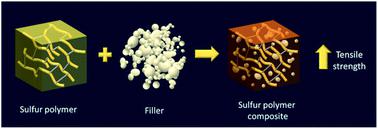当前位置:
X-MOL 学术
›
Polym. Chem.
›
论文详情
Our official English website, www.x-mol.net, welcomes your
feedback! (Note: you will need to create a separate account there.)
Incorporation of fillers to modify the mechanical performance of inverse vulcanised polymers
Polymer Chemistry ( IF 4.1 ) Pub Date : 2022-06-20 , DOI: 10.1039/d2py00321j Veronica Hanna 1 , Peiyao Yan 1 , Samuel Petcher 1 , Tom Hasell 1
Polymer Chemistry ( IF 4.1 ) Pub Date : 2022-06-20 , DOI: 10.1039/d2py00321j Veronica Hanna 1 , Peiyao Yan 1 , Samuel Petcher 1 , Tom Hasell 1
Affiliation

|
Sulfur is a by-product of the refinement of crude oil and natural gas, produced at millions of tonnes per annum, resulting in large overground storage of elemental sulfur. “Inverse vulcanisation” allows for the use of high proportions of sulfur to synthesise inverse vulcanised polymers. However, inverse vulcanised polymers need to be further improved in their mechanical performance to widen their applications. Like with many conventional polymers, fillers can also be used to tailor the mechanical properties of inverse vulcanised polymers, for example, by increasing their tensile strength. The use of the polymer, sulfur-1,3-diispropenylbenzene (S-DIB), as a model system for the addition of fillers (carbon black, cellulose microfibres, and nanoclay) at 2–10 wt% (weight percentage) and their effect on the mechanical properties of the resultant composite is reported herein. Following optimisation with S-DIB, the technique was shown to be transferable to related polymer systems.
中文翻译:

掺入填料以改善反硫化聚合物的机械性能
硫是原油和天然气精炼的副产品,每年生产数百万吨,导致元素硫的大量地上储存。“反向硫化”允许使用高比例的硫来合成反向硫化聚合物。然而,反向硫化聚合物的机械性能需要进一步提高,以扩大其应用范围。与许多传统聚合物一样,填料也可用于调整反硫化聚合物的机械性能,例如,通过提高其拉伸强度。使用聚合物 1,3-二异丙烯基苯 (S-DIB) 作为添加填料(炭黑、纤维素微纤维、和纳米粘土)在 2-10 wt%(重量百分比),本文报道了它们对所得复合材料的机械性能的影响。在使用 S-DIB 进行优化后,该技术被证明可以转移到相关的聚合物系统中。
更新日期:2022-06-23
中文翻译:

掺入填料以改善反硫化聚合物的机械性能
硫是原油和天然气精炼的副产品,每年生产数百万吨,导致元素硫的大量地上储存。“反向硫化”允许使用高比例的硫来合成反向硫化聚合物。然而,反向硫化聚合物的机械性能需要进一步提高,以扩大其应用范围。与许多传统聚合物一样,填料也可用于调整反硫化聚合物的机械性能,例如,通过提高其拉伸强度。使用聚合物 1,3-二异丙烯基苯 (S-DIB) 作为添加填料(炭黑、纤维素微纤维、和纳米粘土)在 2-10 wt%(重量百分比),本文报道了它们对所得复合材料的机械性能的影响。在使用 S-DIB 进行优化后,该技术被证明可以转移到相关的聚合物系统中。









































 京公网安备 11010802027423号
京公网安备 11010802027423号